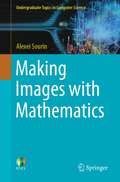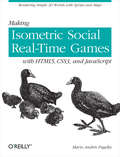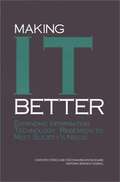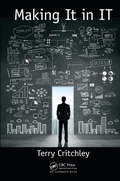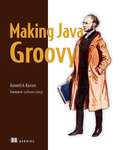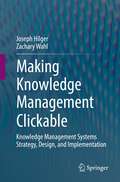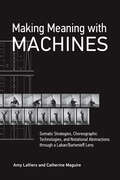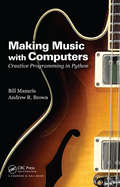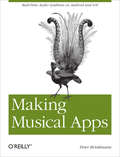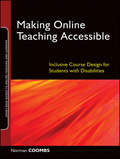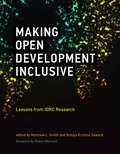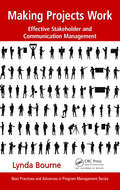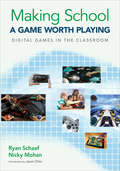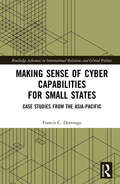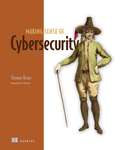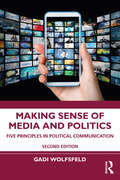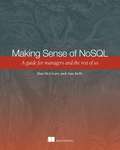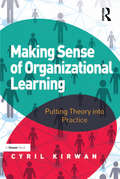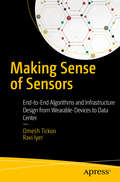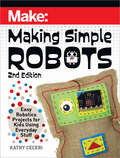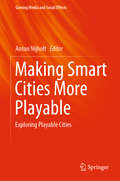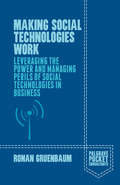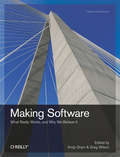- Table View
- List View
Making Images with Mathematics (Undergraduate Topics in Computer Science)
by Alexei SourinThis textbook teaches readers how to turn geometry into an image on a computer screen. This exciting journey begins in the schools of the ancient Greek philosophers, and describes the major events that changed people’s perception of geometry. The readers will learn how to see geometry and colors beyond simple mathematical formulas and how to represent geometric shapes, transformations and motions by digital sampling of various mathematical functions.Special multiplatform visualization software developed by the author will allow readers to explore the exciting world of visual immersive mathematics, and the book software repository will provide a starting point for their own sophisticated visualization applications. Making Images with Mathematics serves as a self-contained text for a one-semester computer graphics and visualization course for computer science and engineering students, as well as a reference manual for researchers and developers.
Making Isometric Social Real-Time Games with HTML5, CSS3, and JavaScript: Rendering Simple 3D Worlds with Sprites and Maps (Oreilly And Associate Ser.)
by Mario Andres PagellaAnyone familiar with Zynga's Farmville understands how fun and addictive real-time social games can be. This hands-on guide shows you how to design and build one of these games from start to finish, with nothing but open source tools. You'll learn how to render graphics, animate with sprites, add sound, validate scores to prevent cheating, and more, using detailed examples and code samples.By the end of the book, you’ll complete a project called Tourist Resort that combines all of the techniques you’ve learned. You’ll also learn how to integrate your game with Facebook. If you’re familiar with JavaScript, HTML5, and CSS3, you’re ready to get started.Use HTML5’s canvas element to build smooth animations with spritesCreate an isometric grid pattern for high-performance graphicsDesign a GUI that works equally well on mobile devices and PCsAdd sound to your game with HTML5’s audio elementImplement the game’s path-finding function with WebWorkersBuild a client data model on the server with PHP and MySQLMake your game come alive with dynamic CSS3 objects
Making It Better: Expanding Information Technology Research To Meet Society's Needs
by National Research CouncilThe flood of information technology (I.T.) products and services entering the market place often obscures the need to nurture the research enterprise. But as I.T. becomes integrated into all aspects of society, the need for research is even greater. And the range of issues that need to be addressed is broader than ever.This new book highlights the fundamental importance of research to ensure that I.T. meets society's expanding needs. Against the background of dramatic change in the I.T. landscape, the committee examines four key questions: Is the scope of I.T. research broad enough-particularly in the arena of large-scale systems-to address government, business, and social applications? Are government and industrial sponsors providing sufficient funding for I.T. research? Is the research net big both big and diverse enough to capture sufficient financial and intellectual resources to advance the field? Are structures and mechanisms for funding and conducting research suited to the new sets of research challenges?
Making It in IT
by Terry CritchleyWritten for those starting a career in IT or whose career is well advanced, this career guide shows how to blaze a path to success through the jungle of modern IT. With a career spanning five decades, the author shares lessons he learned the hard way so readers do not have to learn them the hard way. <P><P>By emphasizing the importance of business processes and applications to IT, this book explains how to understand the value and positioning of hardware and software technology in order to make appropriate decisions. It addresses the importance of IT architecture and the roles service and systems management play. It also explains service level agreements (SLAs) and provides sample SLAs. <P><P>Readers learn how to conduct IT assessments using SWOT (strengths, weaknesses, opportunities, and threats) analysis. It also shows how to use root-cause analysis (RCA) to detect the sources of failure and poor performance. An overview of risk management and the steps involved in developing a business continuity plan are also included. The book looks at all facets of an IT professional’s career. It explains how to build an IT team and examines the roles and responsibilities within the team. It shows how to provide professional customer care to IT clients. Business executives recognize the importance of IT, and this book shows technology professionals how to thrive in the business world. It covers: <li>Making effective presentations <li>Report and proposal writing <li>Negotiating and persuasion skills <li>Running productive meetings <li>Time and stress management <li>The book also discusses such important career skills as listening, continual and incremental learning, and communicating at all levels. <P><P>From its templates and checklists to its comprehensive and holistic view of a successful IT career, this book is an indispensable guide for every professional working in IT today and tomorrow.
Making Java Groovy
by Kenneth KousenSummaryMaking Java Groovy is a practical handbook for developers who want to blend Groovy into their day-to-day work with Java. It starts by introducing the key differences between Java and Groovy—and how you can use them to your advantage. Then, it guides you step-by-step through realistic development challenges, from web applications to web services to desktop applications, and shows how Groovy makes them easier to put into production.About this BookYou don't need the full force of Java when you're writing a build script, a simple system utility, or a lightweight web app—but that's where Groovy shines brightest. This elegant JVM-based dynamic language extends and simplifies Java so you can concentrate on the task at hand instead of managing minute details and unnecessary complexity.Making Java Groov is a practical guide for developers who want to benefit from Groovy in their work with Java. It starts by introducing the key differences between Java and Groovy and how to use them to your advantage. Then, you'll focus on the situations you face every day, like consuming and creating RESTful web services, working with databases, and using the Spring framework. You'll also explore the great Groovy tools for build processes, testing, and deployment and learn how to write Groovy-based domain-specific languages that simplify Java development.Written for developers familiar with Java. No Groovy experience required.Purchase of the print book includes a free eBook in PDF, Kindle, and ePub formats from Manning Publications.What's InsideEasier JavaClosures, builders, and metaprogrammingGradle for builds, Spock for testingGroovy frameworks like Grails and GriffonAbout the AuthorKen Kousen is an independent consultant and trainer specializing in Spring, Hibernate, Groovy, and Grails.Table of ContentsPART 1: UP TO SPEED WITH GROOVYWhy add Groovy to Java? Groovy by exampleCode-level integrationUsing Groovy features in JavaPART 2: GROOVY TOOLSBuild processesTesting Groovy and Java projectsPART 3: GROOVY IN THE REAL WORLDThe Spring frameworkDatabase accessRESTful web services Building and testing web applications
Making Knowledge Management Clickable: Knowledge Management Systems Strategy, Design, and Implementation
by Joseph Hilger Zachary WahlThis book bridges the gap between knowledge management and technology. It embraces the complete lifecycle of knowledge, information, and data from how knowledge flows through an organization to how end users want to handle it and experience it. Whether your intent is to design and implement a single technology or a complete collection of KM systems, this book provides the foundations necessary for success. It will help you understand your organization’s needs and opportunities, strategize and prioritize features and functions, design with the end user in mind, and finally build a system that your users will embrace and which will realize meaningful business value for your organization. The book is the culmination of the authors’ collective careers, a combined sixty years of experience doing exactly what is detailed in this book. Their guidance has been honed by their own successes and failures as well as many others they have researched in order to provide a comprehensive study on KM transformations and the technologies that help to enable them. They have successfully applied this knowledge as the founders and leaders of the world’s largest dedicated knowledge management consultancy, which runs these projects for many of the world’s most complex organizations. They are writing as practitioners directly to other practitioners with the intent to enable them to apply and benefit from their knowledge and experience.“Compelling reading for KM practitioners looking to ensure their technology decisions support their business and organizational objectives.” - Margot Brown, Director of Knowledge Management, World Bank Group "We are two years into our KM Transformation and if I’d had this book beforehand, it would have made the journey smoother and faster! This is a great playbook for how to plan, organize, and execute a KM transformation." - Stephanie Hill, Senior Director, Global Customer Services, PayPal
Making Meaning with Machines: Somatic Strategies, Choreographic Technologies, and Notational Abstractions through a Laban/Bartenieff Lens
by Amy LaViers Catherine MaguireA rigorous primer in movement studies for designers, engineers, and scientists that draws on the fields of dance and robotics.How should a gestural interface react to a &“flick&” versus a &“dab&”? Versus a &“punch&”? Should robots reach out to a human counterpart with a direct, telescoping action or through a circuitous arc in space? Just as different movements express the different internal states of human movers, so too can the engineered systems behind robots. In Making Meaning with Machines, Amy LaViers and Catherine Maguire offer a refreshingly embodied approach to machine design that supports the growing need to make meaning with machines by using the field of movement studies, including choreography, somatics, and notation, to engage in the process of designing expressive robots.Drawing upon the Laban/Bartenieff tradition, LaViers and Maguire sharpen the movement analysis methodology, expanding the material through their work with machines and putting forward new conventions, such as capitalization, naming, and notation schemes, that make the embodied work more legible for academic contexts. The book includes an overview of movement studies, exercises that define the presented taxonomy and principles of movement, case studies in movement analysis of both humans and robots, and state-of-the-art research at the intersection of robotics and dance.Making Meaning with Machines is a much-needed primer for observing, describing, and creating a wide array of movement patterns, which ultimately can help facilitate broader and better design choices for roboticists, technologists, and designers.
Making Music with Computers: Creative Programming in Python (Chapman And Hall/crc Textbooks In Computing Ser. #13)
by Bill ManarisTeach Your Students How to Use Computing to Explore Powerful and Creative IdeasIn the twenty-first century, computers have become indispensable in music making, distribution, performance, and consumption. Making Music with Computers: Creative Programming in Python introduces important concepts and skills necessary to generate music with computers.
Making Musical Apps
by Peter BrinkmannWant to turn your mobile device into a musical instrument? Or equip your game with interactive audio, rather than canned samples? You can do it with Pure Data (Pd), an open source visual programming environment that lets you manipulate digital audio in real time. This concise book shows you how to use Pd--with help from the libpd library--as an easily embeddable and widely portable sound engine. Whether you're an audio developer looking to create musical apps with sophisticated audio capabilities, or an application developer ready to enhance mobile games with real-time procedural audio, Making Musical Apps introduces you to Pd and libpd, and provides hands-on instructions for creating musical apps for Android and iOS. Get a crash course in Pd, and discover how to generate and control sounds Learn how to create and deploy algorithmic compositions that react to a user's activity and environment Use Java or Objective-C to integrate Pd and libpd into mobile apps Learn the steps necessary to build libpd-based apps for Android and iOS
Making Musical Apps: Real-time audio synthesis on Android and iOS
by Peter BrinkmannWant to turn your mobile device into a musical instrument? Or equip your game with interactive audio, rather than canned samples? You can do it with Pure Data (Pd), an open source visual programming environment that lets you manipulate digital audio in real time. This concise book shows you how to use Pd—with help from the libpd library—as an easily embeddable and widely portable sound engine.Whether you’re an audio developer looking to create musical apps with sophisticated audio capabilities, or an application developer ready to enhance mobile games with real-time procedural audio, Making Musical Apps introduces you to Pd and libpd, and provides hands-on instructions for creating musical apps for Android and iOS.Get a crash course in Pd, and discover how to generate and control soundsLearn how to create and deploy algorithmic compositions that react to a user’s activity and environmentUse Java or Objective-C to integrate Pd and libpd into mobile appsLearn the steps necessary to build libpd-based apps for Android and iOS
Making Online Teaching Accessible: Inclusive Course Design for Students with Disabilities
by Norman CoombsMaking Online Teaching Accessible offers online teachers, instructional designers, and content developers a comprehensive resource for designing online courses and delivering course content that is accessible for all students including those with visual and audio disabilities. Grounded in the theories of learner-centered teaching and successful course design, Making Online Teaching Accessible outlines the key legislation, decisions, and guidelines that govern online learning. The book also demystifies assistive technologies and includes step-by-step guidance for creating accessible online content using popular programs like Microsoft Office and Adobe Acrobat, as well as multimedia tools. Including a wealth of helpful tips and suggestions for effectively communicating with disabled students, the book contains practical advice on purchasing accessible course management systems, developing solutions for inaccessibility issues, and creating training materials for faculty and staff to make online learning truly accessible.
Making Open Development Inclusive: Lessons from IDRC Research (International Development Research Centre)
by Matthew L. Smith and Ruhiya Kristine SewardDrawing on ten years of empirical work and research, analyses of how open development has played out in practice.A decade ago, a significant trend toward openness emerged in international development. "Open development" can describe initiatives as disparate as open government, open health data, open science, open education, and open innovation. The theory was that open systems related to data, science, and innovation would enable more inclusive processes of human development. This volume, drawing on ten years of empirical work and research, analyzes how open development has played out in practice.
Making Projects Work: Effective Stakeholder and Communication Management (Best Practices in Portfolio, Program, and Project Management)
by Lynda BourneThis book provides a framework for understanding and managing factors required for achieving successful project and program outcomes. It presents guidelines to help readers develop an understanding of governance and its connection to strategy as the starting point for decisions on what work needs to be done. The book describes how to craft appropriate communication strategies to develop and maintain successful relationships with stakeholders. It highlights the strengths and weaknesses of existing project controls and outlines effective communication techniques for managing expectations and acquiring the support required for successful delivery.
Making School a Game Worth Playing: Digital Games in the Classroom
by Dr Ryan L. Schaaf Ms Nicky MohanIntegrate game-based learning for 21st Century skills success! This straightforward, easy-to-follow guide from experts Schaaf and Mohan helps you leverage technology students love best – digital video games. With step-by-step strategies, you’ll easily find, evaluate, and integrate gaming into your existing lesson plans or completely redesign your classroom. Teachers learn to use well-designed game elements to: Promote meaningful student buy-in Create student-centered, collaborative learning spaces Teach and assess 21st Century Fluencies aligned to Common Core State Standards Address multiple intelligences using research-based strategies Includes a detailed implementation outline. Create engaged, adventure-filled learning with this resourceful guide!
Making School a Game Worth Playing: Digital Games in the Classroom
by Dr Ryan L. Schaaf Ms Nicky MohanIntegrate game-based learning for 21st Century skills success! This straightforward, easy-to-follow guide from experts Schaaf and Mohan helps you leverage technology students love best – digital video games. With step-by-step strategies, you’ll easily find, evaluate, and integrate gaming into your existing lesson plans or completely redesign your classroom. Teachers learn to use well-designed game elements to: Promote meaningful student buy-in Create student-centered, collaborative learning spaces Teach and assess 21st Century Fluencies aligned to Common Core State Standards Address multiple intelligences using research-based strategies Includes a detailed implementation outline. Create engaged, adventure-filled learning with this resourceful guide!
Making Sense of Cyber Capabilities for Small States: Case Studies from the Asia-Pacific (Routledge Advances in International Relations and Global Politics)
by Francis C. DomingoDomingo explores the potential of cyber capabilities for small states in the Asia-Pacific, the most active region for cyber conflict. He develops a systematic explanation for why Brunei, New Zealand, and Singapore have developed or are developing cyber capabilities. Studies on cyber conflict and strategy have substantially increased in the past decade but most have focused on the cyber operations of powerful states. This book moves away from the prominence of powerful states and explores the potential of cyber capabilities for small states in the Asia-Pacific, the most active region for cyber conflict. It develops a systematic explanation of why Brunei, New Zealand, and Singapore have developed or are developing cyber capabilities despite its obscure strategic value. The book argues that the distribution of power in the region and a "technology-oriented" strategic culture are two necessary conditions that influence the development of cyber capabilities in small states. Following this argument, the book draws on neoclassical realism as a theoretical framework to account for the interaction between these two conditions. The book also pursues three secondary objectives. First, it aims to determine the constraints and incentives that affect the utilization of cyber capabilities as foreign policy instruments. Second, the book evaluates the functionality of these cyber capabilities for small states. Lastly, it assesses the implications of employing cyber capabilities as foreign policy tools of small states. This book will be an invaluable resource for academics and security analysts working on cyber conflict, military strategy, small states, and International Relations in general.
Making Sense of Cybersecurity
by Thomas KranzA jargon-busting guide to the key concepts, terminology, and technologies of cybersecurity. Perfect for anyone planning or implementing a security strategy. In Making Sense of Cybersecurity you will learn how to: Develop and incrementally improve your own cybersecurity strategy Detect rogue WiFi networks and safely browse on public WiFi Protect against physical attacks utilizing USB devices or building access cards Use the OODA loop and a hacker mindset to plan out your own attacks Connect to and browse the Dark Web Apply threat models to build, measure, and improve your defenses Respond to a detected cyber attack and work through a security breach Go behind the headlines of famous attacks and learn lessons from real-world breaches that author Tom Kranz has personally helped to clean up. Making Sense of Cybersecurity is full of clear-headed advice and examples that will help you identify risks in your organization and choose the right path to apply the important security concepts. You'll learn the three pillars of a successful security strategy and how to create and apply threat models that will iteratively improve your organization's readiness. Foreword by Naz Markuta. About the technology Someone is attacking your business right now. Understanding the threats, weaknesses, and attacks gives you the power to make better decisions about how to secure your systems. This book guides you through the concepts and basic skills you need to make sense of cybersecurity. About the book Making Sense of Cybersecurity is a crystal-clear overview of common cyber threats written for business and technical readers with no background in security. You&’ll explore the core ideas of cybersecurity so you can effectively talk shop, plan a security strategy, and spot your organization&’s own weak points. By examining real-world security examples, you&’ll learn how the bad guys think and how to handle live threats. What's inside Develop and improve your cybersecurity strategy Apply threat models to build, measure, and improve your defenses Detect rogue WiFi networks and safely browse on public WiFi Protect against physical attacks About the reader For anyone who needs to understand computer security. No IT or cybersecurity experience required. About the author Tom Kranz is a security consultant with over 30 years of experience in cybersecurity and IT. Table of Contents 1 Cybersecurity and hackers 2 Cybersecurity: Everyone&’s problem PART 1 3 Understanding hackers 4 External attacks 5 Tricking our way in: Social engineerin 6 Internal attacks 7 The Dark Web: Where is stolen data traded? PART 2 8 Understanding risk 9 Testing your systems 10 Inside the security operations center 11 Protecting the people 12 After the hack
Making Sense of Media and Politics: Five Principles in Political Communication
by Gadi WolfsfeldIn Making Sense of Media and Politics, Gadi Wolfsfeld introduces readers to the most important concepts for examining the interrelationship of media and politics. Five major principles are used to summarize the major arguments: Political power can usually be translated into power over all forms of media. When the powerful lose control over the political environment, they also lose control over all forms of media. Every political story that appears in every form of media is biased. All forms of media are primarily dedicated to telling good stories, which can have a major impact on political processes. Many of the most important effects of the various forms of media on citizens tend to be unintentional and unnoticed. By identifying these five key principles of political communication, Wolfsfeld examines those who package and send political messages, those who transform political messages into stories, and the effects this can have on citizens, and how the more active members of the public ("users") can initiate their own stories. The result is a brief, engaging guide to help make sense of the wider world of media and politics and an essential companion to more in-depths studies of the field. New to the Second Edition Up-to-date coverage of major political events in the last decade, including the landmark US elections of 2016 and 2020. Devotes more attention to the "hybrid media system" that has developed over the last decade, providing a greater balance between traditional "news" and social media in particular. Includes more cross-national research, especially in non-Western and non-democratic countries. Refines the five principles of political communication to better reflect contemporary media trends. Covers key emerging topics including misinformation and threats to democratic institutions, new forms of political engagement, and the economic base of the various forms of media.
Making Sense of NoSQL: A guide for managers and the rest of us
by Ann Kelly Dan McCrearySummaryMaking Sense of NoSQL clearly and concisely explains the concepts, features, benefits, potential, and limitations of NoSQL technologies. Using examples and use cases, illustrations, and plain, jargon-free writing, this guide shows how you can effectively assemble a NoSQL solution to replace or augment the traditional RDBMS you have now.About this BookIf you want to understand and perhaps start using the new data storage and analysis technologies that go beyond the SQL database model, this book is for you. Written in plain language suitable for technical managers and developers, and using many examples, use cases, and illustrations, this book explains the concepts, features, benefits, potential, and limitations of NoSQL.Making Sense of NoSQL starts by comparing familiar database concepts to the new NoSQL patterns that augment or replace them. Then, you'll explore case studies on big data, search, reliability, and business agility that apply these new patterns to today's business problems. You'll see how NoSQL systems can leverage the resources of modern cloud computing and multiple-CPU data centers. The final chaptersshow you how to choose the right NoSQL technologies for your own needs.Managers and developers will welcome this lucid overview of the potential and capabilities of NoSQL technologies.Purchase of the print book includes a free eBook in PDF, Kindle, and ePub formats from Manning Publications.What's InsideNoSQL data architecture patternsNoSQL for big dataSearch, high availability, and securityChoosing an architectureAbout the AuthorsDan McCreary and Ann Kelly lead an independent training and consultancy firm focused on NoSQL solutions and are cofounders of the NoSQL Now! Conference.Table of ContentsPART 1 INTRODUCTIONNoSQL: It's about making intelligent choicesNoSQL conceptsPART 2 DATABASE PATTERNSFoundational data architecture patternsNoSQL data architecture patternsNative XML databasesPART 3 NOSQL SOLUTIONSUsing NoSQL to manage big dataFinding information with NoSQL searchBuilding high-availability solutions with NoSQLIncreasing agility with NoSQLPART 4 ADVANCED TOPICSNoSQL and functional programming Security: protecting data in your NoSQL systems Selecting the right NoSQL solution
Making Sense of Organizational Learning: Putting Theory into Practice
by Cyril KirwanThe ability of a business to engage in real organizational learning and to do so faster and in a more sustainable way than its competitors is being increasingly seen as an essential component of success. In Making Sense of Organizational Learning, Cyril Kirwan examines the wide range of factors necessary to create and sustain organizational learning and knowledge at all levels. At the individual level, the generation of continuous learning opportunities and reflection on experiences are critically important. At the team level, it’s about encouraging collaboration, team learning and the sharing of knowledge. At the organizational level, the emphasis is on building systems to capture and share knowledge and providing strategic leadership for learning. The book shows you how you can best exploit the knowledge that already exists within your organization while at the same time develop the capability of the people that work there. It deals in turn with individual learning; learning with others; learning in organizations; and in particular the role of the HR function and of line managers. Each chapter provides theoretical background and real-world examples. Diagnostic questionnaires, checklists and other tools are also included. Making Sense of Organizational Learning provides an evidence-based argument for the adoption of effective organizational learning policies and practices, and offers a real opportunity to improve performance. Thinking practitioners working in and around learning and development or organization development will find it invaluable, as will those undertaking post-graduate study in HR and related disciplines.
Making Sense of Sensors
by Omesh Tickoo Ravi IyerMake the most of the common architectures used for deriving meaningful data from sensors. This book provides you with the tools to understand how sensor data is converted into actionable knowledge and provides tips for in-depth work in this field.Making Sense of Sensors starts with an overview of the general pipeline to extract meaningful data from sensors. It then dives deeper into some commonly used sensors and algorithms designed for knowledge extraction. Practical examples and pointers to more information are used to outline the key aspects of Multimodal recognition. The book concludes with a discussion on relationship extraction, knowledge representation, and management. In today’s world we are surrounded by sensors collecting various types of data about us and our environments. These sensors are the primary input devices for wearable computers, IoT, and other mobile devices. The information is presented in way that allows readers to associate the examples with their daily lives for better understanding of the concepts.What You'll LearnLook at the general architecture for sensor based data Understand how data from common domains such as inertial, visual and audio is processedMaster multi-modal recognition using multiple heterogeneous sensorsTransition from recognition to knowledge through relationship understanding between entitiesLeverage different methods and tools for knowledge representation and managementWho This Book Is ForNew college graduates and professionals interested in acquiring knowledge and the skills to develop innovative solutions around today's sensor-rich devices.
Making Simple Robots: Easy Robotics Projects for Kids Using Everyday Stuff
by Kathy CeceriMaking Simple Robots is based on the idea that anybody can build a robot! That includes kids, educators, parents, and anyone who didn't make it to engineering school. If you can cut, fold, and tape a piece of paper to make a tube or a box, you can build a no-tech robotic part. In fact, many of the models in this book are based upon real-life prototypes -- working models created in research labs and companies. What's more, if you can use the apps on your smartphone, you can quickly learn to tell robots what to do using free, online, beginner-level software like MIT's Scratch and Microsoft MakeCode.The projects in this book which teach you about electric circuits by making jumping origami frogs with eyes that light up when you get them ready to hop. You'll practice designing all-terrain robot wheel-legs with free, online Tinkercad software, and you'll create files ready for 3D printing. You'll also learn to sew -- and code -- a cyborg rag doll with a blinking electronic "eye."Each project includes step-by-step directions and clear illustrations and photographs. Along the way, you'll learn about the real research behind the DIY version, find shortcuts for making projects easier when needed, and get suggestions for adding to the challenge as your skill set grows.
Making Smart Cities More Playable: Exploring Playable Cities (Gaming Media and Social Effects)
by Anton NijholtThis book explores the ways in which the broad range of technologies that make up the smart city infrastructure can be harnessed to incorporate more playfulness into the day-to-day activities that take place within smart cities, making them not only more efficient but also more enjoyable for the people who live and work within their confines. The book addresses various topics that will be of interest to playable cities stakeholders, including the human–computer interaction and game designer communities, computer scientists researching sensor and actuator technology in public spaces, urban designers, and (hopefully) urban policymakers. This is a follow-up to another book on Playable Cities edited by Anton Nijholt and published in 2017 in the same book series, Gaming Media and Social Effects.
Making Social Technologies Work: Leveraging the Power and Managing Perils of Social Technologies in Business (Palgrave Pocket Consultants)
by Ronan GruenbaumEmbracing social technologies at work is not just a blog from the CEO. It is about understanding all the opportunities where social media and technology activities could improve your company from marketing to operations. A practical guide for managers and an informative window into the world of social technologies in business.
Making Software: What Really Works, and Why We Believe It (O'reilly Ser.)
by Andy Oram Greg WilsonMany claims are made about how certain tools, technologies, and practices improve software development. But which claims are verifiable, and which are merely wishful thinking? In this book, leading thinkers such as Steve McConnell, Barry Boehm, and Barbara Kitchenham offer essays that uncover the truth and unmask myths commonly held among the software development community. Their insights may surprise you.Are some programmers really ten times more productive than others?Does writing tests first help you develop better code faster?Can code metrics predict the number of bugs in a piece of software?Do design patterns actually make better software?What effect does personality have on pair programming?What matters more: how far apart people are geographically, or how far apart they are in the org chart?Contributors include:Jorge ArandaTom BallVictor R. BasiliAndrew BegelChristian BirdBarry BoehmMarcelo CataldoSteven ClarkeJason CohenRobert DeLineMadeline DiepHakan ErdogmusMichael GodfreyMark GuzdialJo E. HannayAhmed E. HassanIsrael HerraizKim Sebastian HerzigCory KapserBarbara KitchenhamAndrew KoLucas LaymanSteve McConnellTim MenziesGail MurphyNachi NagappanThomas J. OstrandDewayne PerryMarian PetreLutz PrecheltRahul PremrajForrest ShullBeth SimonDiomidis SpinellisNeil ThomasWalter TichyBurak TurhanElaine J. WeyukerMichele A. WhitecraftLaurie WilliamsWendy M. WilliamsAndreas ZellerThomas Zimmermann
